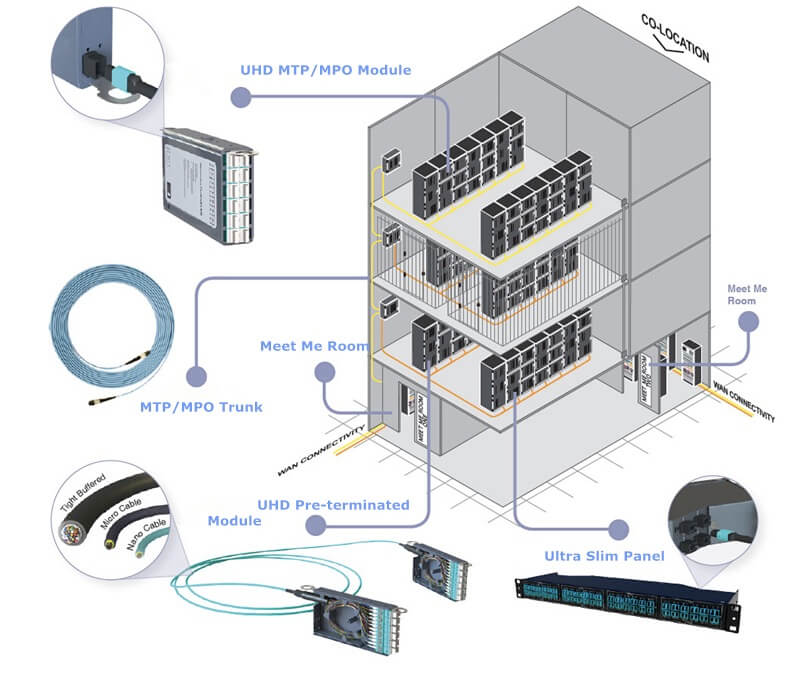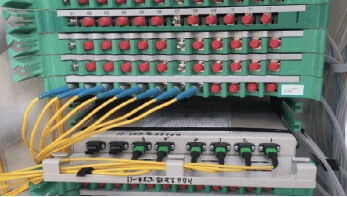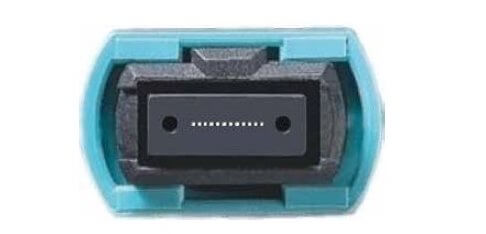The fiber connectors we often use are SC, FC, and LC. These connectors are designed for single-core connections, so each pair of them can connect just one optical fiber. In data centers, we often use a multi-core connector, such as the MPO (Multi-fiber Push On) connector, which can handle connections for 2 to 32 cores in a single pair of connectors.
What is an MPO Connector?
An MPO connector is a multi-core plug-in connector that comprises a female array connector, a male array connector, and an array adapter. The male array connector is equipped with 2 guide pins, while the female array connector lacks pins but features 2 pin holes. To establish a connection, the guide pins and pin holes are aligned and secured using the adapter.

MPO connectors are available in various core configurations, including 8, 12, 16, 24, and a maximum of 32 cores. Despite these core variations, the connectors’ size and shape largely remain consistent, although they are slightly larger than the commonly used SC connectors.
It’s important to note that MPO connectors typically exhibit higher insertion loss when compared to single-core connectors. Multi-mode MPO connectors generally have an insertion loss of approximately 0.25dB, while traditional single-mode MPO connectors tend to have an insertion loss of around 0.6 dB. Achieving precise alignment of multiple fiber cores simultaneously can be challenging, leading to variations in insertion loss among the cores within the same connector. However, low-loss single-mode MPO connectors provide improved performance, with a maximum insertion loss not exceeding 0.35 dB.
Applications of MPO Connectors
MPO connectors play a vital role in data center cabling systems. These connectors are commonly employed due to the prevalence of high-speed optical modules in network equipment that use MPO interfaces. To enable MPO connections, the corresponding components, such as fiber jumpers, trunk cables, and fiber distribution frames (ODF), must be compatible with MPO technology.

Backbone cables are also called MPO trunk cables. An MPO patch cord is essentially a multi-core optical cable assembly with MPO plugs pre-installed at both ends. The core numbers for MPO fiber cords are typically 8, 12, 16, or 24, and the outer diameter of the fiber patch cable is approximately 3.0mm.
In terms of the distribution frame, it can be categorized based on the type of optical fiber interface it accommodates, resulting in MPO interface units and LC interface units. The patch panel usually features multiple MPO ports, with the MPO connector of the backbone cable directly connecting to the MPO adapter.

Additionally, the LC interface unit includes multiple MPO-LC conversion modules. These modules can convert the cores of 1 to 3 MPO horizontal cables into multiple LC optical fiber interfaces. For example, they can transform a 12-core MPO patch fiber into 12 LC optical fiber interfaces.

In practice, if a network device employs an MPO interface, MPO fiber cords should be used. Conversely, if the network device has an LC interface, use LC-LC fiber cords when connecting to the LC port of the distribution frame, and employ MPO-LC breakout cable when connecting to the MPO port of the distribution frame.
The Role of MPO Connectors in Communication Networks
MPO connectors are widely used in data centers for several reasons. Firstly, they meet the connection requirements of MPO optical modules in data equipment. Secondly, MPO connectors offer high-density connections, which help keep the cabling in computer rooms organized and reduce the space needed for wiring systems compared to single-core connections.
In communication equipment rooms, single-core fiber jumpers with a 2.0mm diameter are commonly used for fiber connections. However, when the number of optical fiber links in a given area is high, the optical fiber wiring can become cluttered and messy. While laying out the same length of fiber on the same path, the workload required for multi-core MPO fiber jumpers is similar to that of single-core fiber jumpers. Nevertheless, the cost of deploying numerous single-core fiber jumpers can be overwhelming.

Communication equipment often comes with LC interfaces in its optical modules. While the optical channels between these devices may not demand MPO connections, using MPO connections can significantly enhance wiring density when there are numerous single-core fiber jumpers sharing the same path.
In theory, if you have many fiber jumpers connecting equipment between rows M and N within a communication equipment room, it’s a good idea to use MPO components for that connection. Likewise, in situations involving optical cable lines or ODN, where A, B, and C are separate ODF units (ODF or OCC) at different locations, if there’s a need to jump a substantial number of fiber cores between A and C through point B, it’s advisable to establish the connection at point B using MPO components, like the backbone optical cable in an ODN distribution box.

Final Words about MPO Connectors
In recent years, optical fiber connections in communication networks have primarily been single-core connections. As communication services have evolved and the demand for active connections has surged, the limitations of single-core connections have become increasingly apparent. Low-density ODF (Optical Distribution Frame) setups occupy significant space in computer rooms, and the massive number of single-core fiber jumpers often exceeds the capacity of wiring racks. Furthermore, the number of roadside optical cable distribution boxes is on the rise, and they are becoming larger in size.
While high-density MPO connections can address these issues, the challenge lies in the fact that communication networks primarily employ single-mode optical fibers. Single-mode MPO connectors are costlier and have higher insertion losses compared to multi-mode MPO connectors. Additionally, MPO connectors and single-mode single-core connectors are relatively large, which can present certain limitations when integrating MPO connectors into communication networks.




